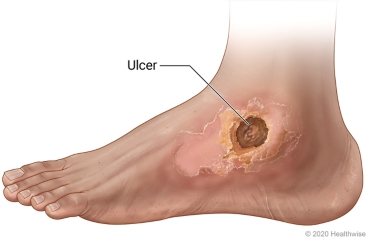What is an arterial skin ulcer?
An arterial ulcer is a painful, deep sore or wound in the skin of the lower leg or foot. The ulcer doesn’t heal as you’d expect an ordinary sore to heal. That’s because there isn’t enough blood flowing to the area. Blood supplies oxygen and nutrients to the tissues.
The ulcer is usually found on skin over pressure points such as the tip of the toe, the heel, or the inner side of the ankle bone. Often it occurs where the skin rubs against clothing or shoes. It may also happen at the site of an injury, even a small one that you wouldn’t expect to cause a problem. Sometimes the ulcer can start as a small dark spot that is painful and grows bigger.
If left untreated, the ulcer may lead to the death or decay of the tissue around the ulcer (gangrene).
What causes it?
Most arterial skin ulcers are caused by poor blood flow in the lower leg along with an injury on the leg or foot. This is often due to narrowing of the arteries that supply blood to the leg.
An injury, even a small one, can become an ulcer if not enough blood can reach it to help it heal. You may get an ulcer on your leg or foot when you scrape or bump it. Or you may get one when something is pressing on it. For example, you may get an ulcer when you wear shoes that rub against your skin.
What puts you at risk of having one?
Many things can put you at risk of having an arterial skin ulcer. These include:
- Smoking.
- High cholesterol.
- High blood pressure.
- Diabetes.
- Obesity.
- Lack of exercise.
- A history of heart attacks or strokes.
- Older age.
What are the symptoms?
You may have an arterial skin ulcer if:
- You have sharp pain with the ulcer. It may be worse at night. There may be less pain if you hang the leg over the side of the bed or you sleep in a chair.
- The ulcer looks like a dry sore with a ridge of dead skin around it or deep inside it.
- Skin around the ulcer may be dark red when the leg is lowered and pale when it’s raised. It may be cool to the touch, shiny, thin, and without hair.
- The ulcer won’t heal, even if it’s kept clean and bandaged.
How is it diagnosed?
Your doctor will look at your ulcer and ask questions about your health. The doctor may press on the skin around the ulcer and check the pulses on your leg and foot. You may also have tests to show how well blood is flowing through the arteries of your leg.
How is it treated?
An arterial skin ulcer is treated by improving blood flow in the area. The treatment may include:
- A procedure to open a narrowed or blocked blood vessel (angioplasty). Or surgery may be done to attach a new artery on both ends of a blockage so blood can go around the part of the blood vessel that is blocked (bypass surgery).
- Medicines, such as aspirin, if needed to help prevent more problems with your blood vessels or blood flow.
Treatment also includes care of the wound, such as:
- Using special coverings on the ulcer that will help protect the area and prevent infection.
- Taking antibiotics if there is an infection.
- Removing dead tissue from the wound (debridement).
If you have pain, your doctor will help you manage it.
In some cases, the tissue in the toes or the foot is too damaged to be saved. When that happens, the affected part of the leg or foot may have to be removed (amputated).
How can you care for your ulcer?
There are things you can do to help your ulcer heal and lower your risk of getting another one.
Current as of: November 16, 2023
Author: Healthwise Staff
Clinical Review Board
All Healthwise education is reviewed by a team that includes physicians, nurses, advanced practitioners, registered dieticians, and other healthcare professionals.

